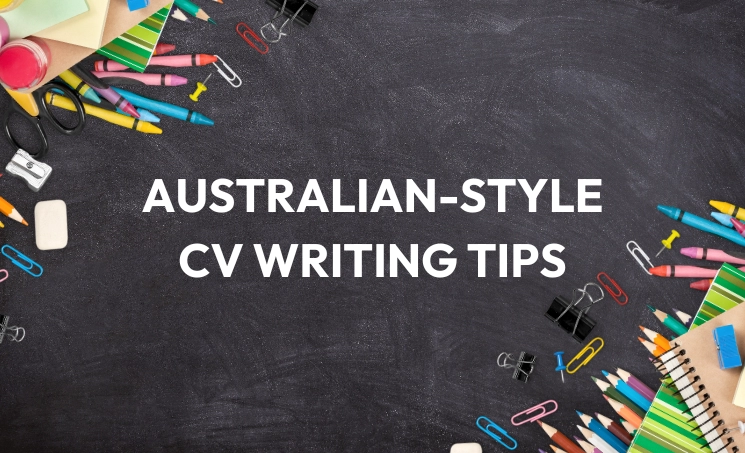The curriculum vitae (CV) is the most important part of a productive job-search process. If you get it right, you will find every other element or aspect of the process easier. There is a unique work culture in every nation, which means country-specific requirements with resumes as well. The same goes for Australia too.
Therefore, when searching for jobs in Australia, you must use a resume suitable for the Australian style. You must know what to include in a resume to make it stand out from a sea of CVs out there. Ideally, you would like your CV to help set you apart from other candidates while leaving a good impression on employers in Australia. Now, you might wonder how to write a resume for Australia that ticks all the boxes, so to speak.
What Makes an Australian-Style Resume Unique?
The Australian CV format is unique with regard to some details, which might determine your odds of getting an instant callback from an employer. Now, what to include in a CV in Australia? We will cover those details later, but before that, let us first discuss some basics.
Resume Versus Curriculum Vitae
The words CV and resume mean the same thing in Australia. You may come across the term resume used more often in Australia, but if you do not, remember that it is synonymous with CV.
The Length of the Resume
It may be a good idea to keep your Australian resume concise, but that does not mean that it should only be a one-page document. You rarely see an Australian CV format with content on multiple pages. One page would suffice if you recently graduated or lack experience. As a professional, though, employers would usually expect you to present a resume consisting of one to two pages. Even in that case, be sure to keep the information in your resume concise because recruiters generally do not get much time to go through each curriculum vitae.
The Tone of Voice and Language in the Resume
There are language-related expectations from employers in Australia for resumes. When you apply for an employment position in Australia, be sure to use a resume written in proper Australian English.
Australian CV Tips and Rules to Follow
- Include Your Personal Details Carefully
As with your photograph, including personal details can make it more likely for employers to categorise you based on race, gender, appearance or age. To avoid that form of categorisation, present only the essential contact details such as your name, phone number, email address, LinkedIn ID, and residential address. Employers in Australia cannot demand extra information from candidates, such as their sexual preference and religion to name a few.
- Include a Career Summary or Objective
It may not be mandatory, but we recommend including a resume summary or objective in your CV. A career objective or resume objective should state what you want to achieve in the position or your career. It is especially good for a recent graduate or a person who seeks a career change. An example of a career objective is as follows:
Graduate in journalism and mass communication seeking a role as a full-time copywriter. Strong skills in English and a good understanding of editing.
A career summary or resume summary should highlight your experience and provide the employer with an idea about your expertise before learning more about both from your CV. It is good to use for a vastly experienced job-seeker. Here is an example of a career summary:
Seasoned copywriter with 5+ years of experience in copywriting. Helped build 6 successful news websites over the last 3 years.
- Detail Your Employment Experience
You should show the experience according to its relevance to the position you apply for and in the reverse chronological order. It is an order starting with your most recent occupation followed by the previous job, and so on. You should present the dates you started and ended the jobs, alongside a summary of your roles, responsibilities, and achievements. Highlight your achievements in the previous job in a quantifiable way when possible. This would show the employer how different you are from the other applicants.
If you show significant gaps in employment in your CV, you would have to explain those as well. Your interviewer would most probably ask you why you have not worked for those months or years. Be sure to have an explanation in mind because unexplained gaps in employment can act as a warning sign for an employer or recruiter.
Besides, it is always a good practice to include a few details about your previous employer as well. Keep reading for more tips on how to make a good resume in the Australian style.
- Use a Summary of Your Skills
Add a list of your skills that offers the employer or recruiter an idea about where you excel and what you can offer them. Besides hard skills, you may include soft skills in your CV, such as 'decision making' and 'leadership', but be sure that you can explain those claims as well. Don't forget to check the keywords or selection criteria in the Australian job posting, and highlight the skills relevant to that job.
- Mention Volunteer Experience
Do you have any experience working for a nonprofit organisation, a community group, an NGO, or a charitable organisation? If so, you should add this information to your CV, as recruiters would appreciate it. Most employers in Australia will show interest in your unpaid work experience, as it serves as proof of your transferable and initiative skills.
Recruiters can often regard volunteer experience as employment experience, particularly if it is associated with your profession and goes well with the period where you were unemployed. If that is the case, you could add it to the employment experience section of your resume.
- Mention Education
Graduates are in demand in Australia, so present your foreign degrees, diplomas or certificates, or other equivalent qualifications. You should present the qualifications that are relevant to that job in the reverse-chronological order. In other words, you should mention your latest qualification first, then the other most recent studies, and so on. Every single entry should include the name of your institute, the relevant dates of your course, your specialisation, and any awards or honours related to your educational history. Are you undertaking any additional course? If so, include that in your CV as well. Read further for more about how to write a CV in the Australian style.
- Use a Photograph Only If Required
If you are not applying for a position where your appearance matters the most (modelling, for example) you should exclude a photograph from the document. If the employer wishes you to add your photo to the resume, it would specify the same in advance. Read on for more tips about how to write a resume for Australia.
Include Your Own Section
You may add another relevant section to the resume if it makes sense for the job you apply for and you want to draw the recruiter's attention to something. For instance, if you apply for a creative job, the employer may value your exhibitions, hobbies, and extracurricular activities. Make sure that whatever you mention in this custom section is relevant to the position you apply for in Australia.
Do's and Don'ts While Writing an Australian-Style Resume
- Write Your Personal Statement in First Person
You should write your personal statement/resume summary in first person. The use of third-person narrative would make it uncomfortable for the reader and make it seem like another individual wrote the resume for you. That said, you should write only this part of your resume in first person. You should list out your achievements and responsibilities without the word 'I'.
- Be Wary of Spelling Mistakes
The use of misspelt words in a resume is a sign of a lack of focus. More than the words themselves, employers are likely to be concerned about the related case of oversight on your part. In other words, it might make them feel that you could overlook errors a lot of times at work. Therefore, you must run a spell check with a purpose-built tool that has more advanced features. It would also be helpful to ensure that your spellings are specific to Australian English (for example, specialisation instead of the American version - specialization).
- Avoid Bad Formatting
Recruiters usually cannot spend much time reading your CV, so be sure to present it logically and neatly, without any fancy colours, charts, graphs or fonts. You must choose the best font for the document, such as Calibri, Arial or Cambria. Remember, creating a resume in Australia is no art project!
- Avoid an Inappropriate File Name
The recruiter should be able to identify you from the name of the document itself. This would be important, especially if they should retrieve your resume from a big database or Inbox.Recruiters will always search resumes by name, so be sure to name your CV accordingly.
- Use an Appropriate Email Address
An email ID represents a personal brand, so choose a professional address for your job-related correspondence. Your email address should contain your first name and surname, should be easy to memorise, and should not contain any special character.
Found it helpful? We can help you take it further. Contact us and get all your queries on PR, visas, migration, scholarships, and others answered today!









